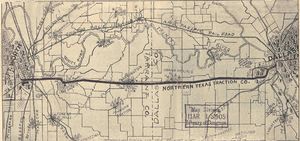Dallas, Texas
Dallas is a major city, county, and metropolitan area in northeastern Texas; the city population in 2006 was 1,250,180. The county population was 2,346,000 in 2000. The Dallas–Fort Worth–Arlington metropolitan area reached 6,145,000 million in 2007 after achieving the largest numeric gain of any metro area in the U.S. between 2006 and 2007, increasing by 162,250. Only New York, Los Angeles and Chicago metro areas were larger, while Houston came next after Dallas.
History
In 1841, two years after his first visit to stake a claim to the land on which Dallas now stands, John Neely Bryan, a Tennessee trader, returned to the then Republic of Texas and built a tiny one-room cabin, the first in Dallas. Ir remains one of the few historical landmarks preserved in the city, and has been moved to the front of the Dallas County Courthouse. Bryan, quick to see the advantages of the National Highway then being built toward his land, founded a village. In 1844 the village was laid out in lots 200 feet square. The only real clue as to the choice of the name for the village is a remark made by Bryan "I named it for my friend Dallas." Dallas County in 1846 was named after George Mifflin Dallas, the current vice-president of the United States. In 1852 Bryan sold his interest in the settlement to Alexander and Sarah Cockrell.
Dallas was incorporated as a town in 1856. That same year several hundred Europeans, followers of the French social philosopher Charles Fourier, attempted to set up a socialistic colony called La Réunion across the river from Dallas. The colony failed in 1858, and many of the colonists moved to Dallas, bringing with them a cosmopolitanism then lacking in other Texas communities. The town, almost completely destroyed by fire in 1860, was rebuilt during the 1860s. During the Civil War, Dallas was the quartermaster, commissary, and administrative headquarters for the Confederate Army, but no fighting occurred near the city.
Dallas was incorporated as a city in 1871 and grew rapidly during the 1870s as a railroad and distribution center for northeast Texas. In 1873, through a trick played on the legislature, the east-west Texas and Pacific Railroad was persuaded to cross at Dallas the Houston and Texas tracks, which were being built northward from the Gulf. By 1900 the city's population reached 38,000 and by 1930 it had risen to about 260,500.
Bibliography
- Acheson, Sam Hanna. Dallas Yesterday, (1977)
- Buckner, Sharry. City Smart: Dallas/Ft. Worth (2000) excerpt and text search
- Calvin, Peter A. Dallas, Texas: A Photographic Portrait (2007) excerpt and text search
- McDonald, . William L. Dallas Rediscovered: A Photographic Chronicle of Urban Expansion, 1870-1925 (1978).
- Payne, Darwin. Dallas: An Illustrated History (1982).
- Rafferty, Robert R. Lone Star Guide to the Dallas/Fort Worth Metroplex, (2nd ed. 2003)
- Rogers, John William. The Lusty Texans of Dallas (3rd ed. 1965)
- WPA Writers' Program. The WPA Dallas Guide and History, ed. Maxine Holmes and Gerald D. Saxon (1939; 1992).
